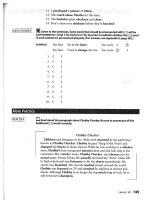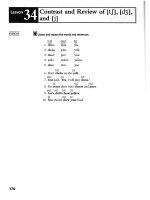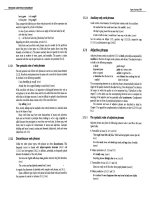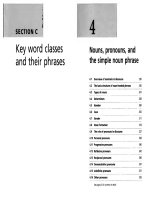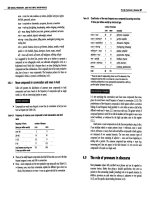Gimson''''s pronunciation of english part 26 pdf
Bạn đang xem bản rút gọn của tài liệu. Xem và tải ngay bản đầy đủ của tài liệu tại đây (1.69 MB, 7 trang )
ax u n- v nzus,,,g anuum ing z'eurwa: anduorningznglu ,, anaaalsona;un z za1
' 1 3 5 Internatlonal English: Prloritles and Tolerances 'Rö/and /Jl5/ were expenuable; for the present model even the somewhat higher
;
,
. sjwuonally loaded /f
,v/ anu js z./ also become expendable. variations in the
of target is iikely tobe the most contenttous and the most utfficult to be Place of articulation of /s,z/ (e.g. dental or retroflex) can be tolerated
.
At this level'rxs sort
bo t 6 It can be set up as a target Ior those who use hvlish as a lin
'
vm tbere is no justification for insisting on the pronunciation of /h/ at ai) i
.
e. jt canprecise a u . ,
itiwr within tiwir own country (and sometimes including surrounding be replaced by zero; alternatively veur and uvuur realizations are acceptable
.
rranca e'
countries) or as a means of intemational communication not necessariiy involv.
ing nauve speakers at all. It involves simplifying the Amakam English set up in Iz.s.1.z A.< , The same applies here as applied in the previous mouel:
913.4 in ways to make it easier for leamers from many different language back- lf'z%l should be kept distinct frcim /tr dr/ (where /r/ may be yl-see next section)
grounds; and it will allow some variation to take account ol these different back- but realizations as (tj djj or Itç,dj
.l are accepuble. The contrast between l#I and
grou nds but not to an extent to naake thepe varieties nxutually u nintelBpble. Iqqi should be naaintained but as for the plosive disd nctons dlscussed in
Reduction of all contrasts which involve a Iow ftmctional load is aliowed. It pro. 912.5. 1. l above can be allowed to be more dependent on voicing than is usual
duces what might still be an intelligible form of English given that communica- in L1 English.
tion using it will be in context: where the language used has a fair degree of
redictabihty. - ''p j tj
os.j .4 Ajjjjrosmuna yojerances in this section are the same as for the previ
-
ous model. A1I variations on /l/ are tolerable (i.e. kl)tll, and (u) in post-vocalic
position). /r/ can be pronounced in all Iyositions where it is in the spellirtg and al I 3
.5. I Consonants
j
jup jejther y) or g(j) js actually preferable. The distinction betw'een some form of
/r/ and some form of /l/ should however be insisted upon since it is of highA
lmost all of what was said in 13.4. 1 concerning consonants in the previous ' '
,
functional load in English. A contrast between /v/ and /w/ should receive high
model applies here but more L1 intrusion is allowable. priority because of the high f
unctional load and substimtion of !v) for either
should be avoided because of potential listener misinterpretation
.I 3.5.1 . I Pleslv'e: /p,t.k/ anö /b,dàW must remain as contrastive sounds.
Mpiration (jnitially) and length ef preceding vowel/nasal/lateral (finally) are stili
the preferred features for the contrasts. But many speakers using English for ' l 3.5' I'5 * ** Tolerances in this section are tlw rame as for the previous mtxlel
,
international purposes may, by matching English to their L1, make these con- l-atittlde i9 allowable in the place of articulation of /n/ (e.g.
dental or retroilex).
trast's depend on voicing alone; this can be tolerated with this target. The same 'l'he Wonunciation of a /g/ following /p/ is allowable (it is usually present in the
applies also where the plosives are followed by /1,z,w,j/l devoicing of the approx- Spelling).
imantl is still to be preferred but lack of this feature can be tolerated. Variations '
in the place of articulation of/t,d/ can be tolerated as they were in the previous . I 3.5 I 4. conzorumv cluxer.
s Final clusters involving C+/t d/ (including past
jtarget (i.e. they Can be dental or retroflexl. Use Of /a/ in Place of nasal and lateral tense e+ may lose their kt d/ as in Amalgam English (and ildeed in RP). some
losion and in sequtnce: Of Plosives is also allowable. The realization of /d/ as a ? further simplificati
tm of clusters can be tolerated. Initial clusters of /s/+C andP
flap Ir1 is again not tfk be entouraged becatkle Of Potential confusion with /r/. And C + /1 r w j/ will often be simplified by leamers at this level Generally speakinp
it still remains impcGant (as in the Previous model) to keep the plosives as p10. use of an intrtlsive vowel is to be prefezred to dropping consonants; and a medial
sives and not allow weakening to frkatives. intrusive vowel is to be preferred to initial intmsive vowel e
.
g. for sport Jsam:t/
rather than kespa:t/ rather than kpmt/ (a1l three are of cours'e likely to i
nclude an
Iz.s.l.a Fricative, As fn tlw previous mouel place of articulation distinctions /r/ from the spelling as well, e,g.
ysapa:rtp.
among fricatives shouiu be retained, /e,ö/ can be allowed to become (lental El,w;
replacement by alveolar xtq can even be tolerateu tlwugh not enceuraged. such
replacement i 's one reason why it was recommended that the weakening of plo.
sives to fricativu shoulu not be allowed: if it were, an achtal reversal of the sim- 1 3.5.2 Vowels
ation in native-speaker Englishes would occur, i.e. /d/ >îöJ and fö/-qtq. cleazly
this is Iikely to -be a more-confusing situation than onlv one-way replacement. ' It is in this area that the requirements of International English most differ from
For the previous mouel, it w&s sugs-esteu that the uistin'ctions be '%w 'een tlw pairs ' those of Amalgam English
, vowel contrasts in general appear to be less cnwial to
.
iritelligibility in Enxlish tlaan consonant contrasts so that a major simplification'
'
: of the vowel syste ''m is possible for International English
.
Moreover a large part
6 This whole section is in the nature of a bypethesis ahout what constittste the characteristics of
such a model. The enly book which tenfronts this preblem and presents some evidence is J
Jenkins (21G ). 7 Lin (7.,*3).

